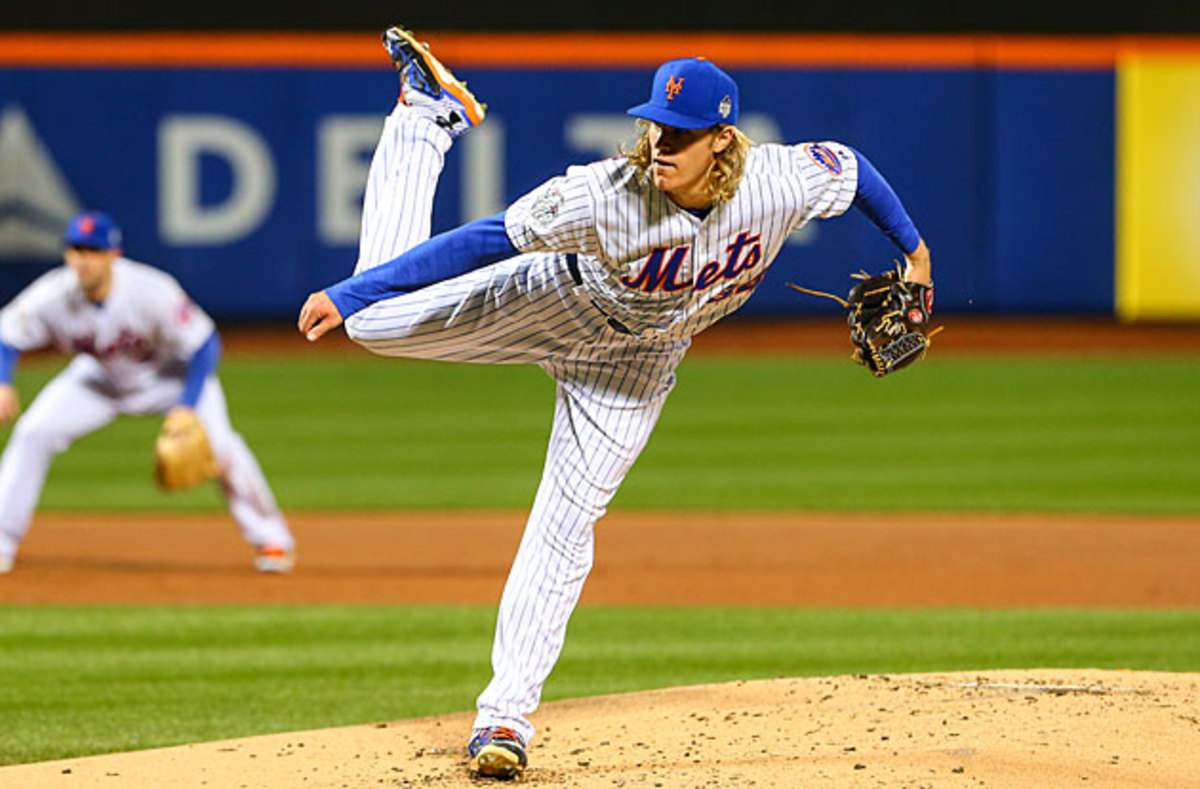Syndergaard's new pitch, Wright's new approach key Mets' win

NEW YORK—The Mets hosted the first World Series game ever played at Citi Field Friday night and a graduation took place. Noah Syndergaard, the team's 23-year-old righthander known for bullying hitters with a fastball that clocks in as high as 101 mph, stood on the mound in the sixth inning with two outs, a two-run lead, the bases loaded and the entire World Series riding on what would happen next.
Syndergaard already had thrown 102 pitches; he had faced only 22 batters the entire regular season that many pitches deep into a game. Twenty-eight of those pitches had occurred just in that inning. And he was now 65 1/3 innings beyond his previous professional high. Had Syndergaard been an automobile, with all those miles on his young arm, he would have been considered way beyond his warranty.
New York manager Terry Collins had righthander Bartolo Colon ready in the bullpen. Alex Rios, a righthanded hitter who had smashed a Syndergaard fastball for an RBI single in the second inning, walked to the plate.
Collins remained in the dugout.
“I wanted Syndergaard’s power over Colon’s sinker,” Collins said.
Noah Syndergaard, Mets show Royals they won’t back down in Game 3 win
Syndergaard was once touted as a prospect with so much power—but perhaps not enough polish on his secondary pitches—that some scouts wondered if he would best be deployed as a reliever. But to appreciate what happened next—and how a 9-3 Mets victory over Kansas City became possible—go back to Sept. 12 in Atlanta. Until then, Syndergaard pitched primarily with his fastball, curveball and changeup. But in bullpen sessions, under the guidance of pitching coach Dan Warthen, Syndergaard was learning how to command a slider. The pitch could be a devastating complement to his fastball, because it mimics a fastball for 50 feet before tilting away from the hitter.

Syndergaard had tried throwing a few sliders early in the season, but he quickly abandoned it. That night in Atlanta, though, Syndergaard replaced his curveball with a slider. He threw 13 of them that night. Only four of them were strikes, but it was a start.
In his next start, against the Yankees, Syndergaard threw 11 sliders—and kept the curveball. The Yankees swung at seven sliders. They made contact only twice.
Now he was truly on his way to being a complete four-pitch starting pitcher: fastball, changeup, curveball and slider.
Now think about Game 3, when Syndergaard came out so wobbly, with the Royals smacking his fastball for six hits among their first 10 cracks at him, that Collins was one batter away from pulling him in favor of lefty John Niese with two outs in the second inning.
“One batter away,” Collins said. “If he got to [Lorenzo] Cain, that was it.”
To stay in the game, the man they call Thor needed more than a hammer in his tool box. He needed his three secondary pitches—which is how he came to be standing there on the mound facing Rios so deep into the game and into the season. How could he justify Collins’ faith? Syndergaard was going to pitch his way out of it, not bully his way.

He started Rios with a slider. Rios took it for a strike. Syndergaard threw that pitch again. Rios hit a grounder toward the middle, where shortstop Wilmer Flores glided to it like a water skimmer over a calm lake, caught it and threw out Rios.
Despite little recognition, Granderson continues to produce for the Mets
Syndergaard had not just kept the score at 5-3. He also had earned his diploma. He escaped the most critical jam of New York's season by relying solely on a pitch he had been throwing with conviction for hardly more than a month. Syndergaard threw 16% sliders in Game 3, the highest percentage in his young career. He now has thrown 37 sliders this month without giving up a hit on any of them.
“The bottom line is he executed two perfect sliders when he had to,” Mets catcher Travis d’Arnaud said. “To do that, under those circumstances, in the World Series, shows you how far he has come, as far as his maturity, his improvement, and what a pitcher he has become.”
• MORE MLB: Full postseason schedule, start times, TV listings
Syndergaard is not yet a finished product. His master’s degree in pitching will come only with time, when he starts stringing together 200-inning seasons. (He is at 198 2/3 this year between the majors and the minors, with a potential Game 7 start looming.) And he showed his immaturity after the game when he admitted he purposely threw a crop-duster of fastball past the chin of Kansas City shortstop Alcides Escobar with his first pitch of the game. The Royals already were upset to see Syndergaard throw high and inside at Escobar. Then, to admit to throwing such a pitch on purpose, he broke the accepted protocols of the game.
#http://www.120sports.com/video/v156019792/syndergaard-sends-a-message
The pitch and the near bragging about it puts the next move in the hands of Chris Young, Kansas City's Game 4 starter. A return salvo from Young could provoke home plate umpire Jim Wolf to issue a warning, and such a warning would favor the Royals more than the Mets because New York starter Steven Matz pitches inside much more than Young.
One other key development happened in Game 3 that also tilted the series: the return of David Wright. Oh, Wright had been in the lineup all postseason long, but the usual snap in his bat had disappeared. The spinal stenosis that kept him out for the much of the year has changed Wright as a hitter, the way back trouble once sapped another New York captain, the Yankees' Don Mattingly, of the speed in his swing.
As a young, healthy hitter, Wright could wait on a fastball as long as possible—let it get deep toward the plate—and still have the bat quickness to send rockets through the gap in right-centerfield. Those days are gone. Of his 44 hits in the regular season, Wright managed only four to rightfield, including only one (a double) for extra bases. He hit just .200 when he taking the ball the other way. And he was getting beat with velocity; Wright batted .083 against power pitchers during the season.
The Royals’ scouts, of course, noticed how late Wright was to the baseball. They ordered a steady dose of velocity against him in the World Series. And for two games, it worked, as Wright went 2-for-11 at Kauffman Stadium.
But then Wright made an adjustment on the off day. He knew velocity was beating him, so he made a point to get started earlier and to get his front foot down sooner. It was an admission all hitters have to make as they age: get the bat head out quicker. Wright, at least while still compromised by his back, would have to make a point of catching fastballs out front, rather than allowing them to get deep.
The adjustments worked immediately. In his first at-bat, Wright hammered a 96-mph fastball from Yordano Ventura, pulling it into the leftfield seats. And when Kelvin Herrera tried to throw a 97-mph fastball past him in the sixth, Wright muscled it into centerfield for a two-run single.
Royals’ Mondesi becomes first player to make MLB debut in World Series
“He was getting his foot down earlier and was more ready to hit,” said Mets hitting coach Kevin Long. “When he gets the bat head out and he’s on time, he’s as good as anybody. That was a good sign tonight that he’s close. Real close.”
Suddenly, after New York dropped two games in Kansas City, all seemed right in the Mets’ world. Their captain was back. The endgame bullpen trio of Addison Reed, Tyler Clippard and Jeurys Familia shut down Team Rally by securing the last nine outs on only 36 pitches. And New York finally managed to get the Royals to swing and miss—18 times, 16 of them by Syndergaard.
But nothing was more important to them than to see Syndergaard use his secondary pitches to last six innings. No pitch was bigger than his last: the slider, his newfound friend, that brought the Mets right back into this series.
